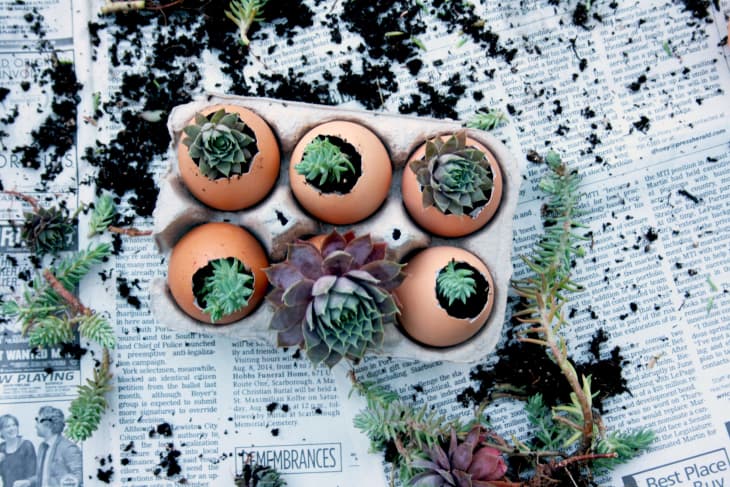6 Unique Succulents That Aren’t All Over Instagram (Yet)

The succulent craze is still going strong—which means it’s getting easier and easier to find unique hybrids and cultivars at local nurseries, online retailers, and even some big-box stores.
If you collect succulents like I do, you know there’s nothing quite like coming across a unique plant to take home. The succulents on this list—all of which I either have owned myself or have sold at the Boston plant shop I managed—will make any collection shine.
Just remember: Do your research to ensure you’re getting a correctly labeled plant. The influx of growers and availability also allows for a greater likelihood of mislabeling. The difference could even come down to the shape of the point on the end of a leaf or the shade of the flower it produces.
Haworthia cooperi var. truncata
While all haworthias are fabulous, the H. cooperi var. truncata is on another level. Native to South Africa, haworthias are generally small plants that enjoy a tight space, making this species perfect houseplant material. The truncata variety with its transparent, “windowed” leaves grows even smaller than other haworthias, so it’s a good candidate for terrariums or that tiny container you’ve been looking to fill.
Like other haworthias, it’s tolerant of lower-light situations—with typical succulent care, it will thrive in a bright light rather than direct light.
Haworthias are also a great plant for animal lovers, as they are nontoxic to cats and dogs, according to the American Society for the Prevention of Cruelty to Animals (ASPCA).
Buy: Haworthia cooperi var. truncata, $4.49 at Mountain Crest Gardens
Kalanchoe tomentosa “Panda Plant”
This kalanchoe is so soft and fuzzy, you may want to take it home to cuddle. Also known as “chocolate soldier,” the panda plant is native to Madagascar and gets its common name from its physical features: soft, gray-green leaves that have chocolate brown markings. In prime growing conditions, it can reach up to 3 feet tall, but most available plants in nurseries are extremely young and small.
In my experience, watering is a bit tricky—this plant droops when it’s both underwatered and overwatered—but it will be smooth going once you find a watering groove. Water only when the soil is completely dry, then saturate thoroughly.
Watch your fur babies with these—the ASPCA lists kalanchoes as toxic to both cats and dogs.
Buy: Kalanchoe tomentosa, $3.49 at Mountain Crest Gardens
Aeonium arboreum “Black Rose Tree”
The “Black Rose Tree” aeonium has deep purple leaves—nearly black—that grow in the shape of a flower on the end of a branch. Aeoniums are sought after for their shape and the ease with which they grow, making them a wonderful addition to any houseplant family.
In order to maintain the darkness of its leaves, the “Black Rose Tree” aeonium needs extremely bright light; otherwise, the leaves will appear lighter with green centers. Water only when the soil dries out completely, and remember that, if you have a larger plant, it will drink a larger quantity of water. Be on the lookout for signs of spider mites and aphids, as aeoniums are particularly vulnerable to these pests.
Buy: Aeonium Arboreum Black Rose, $8.36 at Etsy
Echeveria “Black Knight”
Speaking of dark-colored succulents, this echeveria is a longtime favorite of many collectors. “Black Knight” is sometimes confused with the “Black Prince” variety, but can be identified by the shape of its leaves, which are slightly wider in the middle, like a sword or dagger. The leaves on a “Black Prince” are shaped more like shields, with very wide middles.
Like the “Black Rose Tree” aeonium, the more sunlight the “Black Knight” gets, the darker the leaves will be. New growth comes in as a bright green shade, providing a delightful contrast to the dark purple mature leaves.
Echeverias are nontoxic to both dogs and cats, according to succulent nursery Mountain Crest Gardens and, regarding Blue Echeveria, the ASPCA.
Buy: Echeveria Black Night, $9.95 at Succulents Box
Senecio serpens “Blue Chalk Sticks”
A dainty, slow-growing plant, this succulent has leaves that look, well, like blue sticks of chalk. Outdoors, in the proper zone, it is used as a ground cover. Indoors, it is typically potted on its own and does not need attention outside of being given bright to bright indirect light and water when the soil has dried all the way through. The soft, chalky blue color of the leaves and the vertical growth pattern make it a perfect design companion to many other succulents.
The Senecio species is toxic to cats and dogs, per the ASPCA.
Buy: Senecio Blue Chalk Sticks (2-inch), $5.45 at Succulents Box
Pachyphytum oviferum “Moonstones”
Meet the adorable succulent with egg-shaped leaves that’s a hot topic of conversation within the collector community. Native to Mexico, Pachyphytum oviferum is frequently mislabeled Graptopetalum amethystinum, Pachyphytum glutinicaule, or Pachyphytum compactum because of the striking similarities between them. The only true way to tell apart the Graptopetalum and Pachyphytum is when they flower: The flowers of the Graptopetalum face upward on the stalk and resemble stars with red tips, while the flowers of the Pachyphytum droop downward on the stalk with no red tips.
Give this baby bright light, and water it when the soil is dried through.
Buy: Moonstones Pachyphytum Oviferum, $6.85 at Amazon